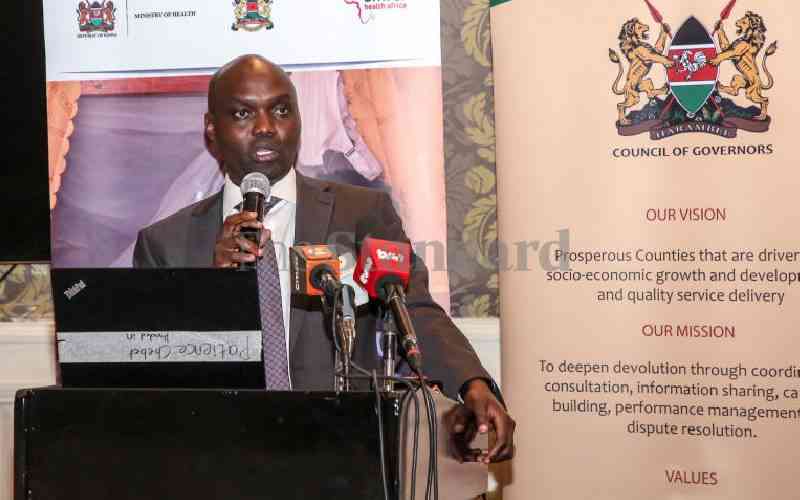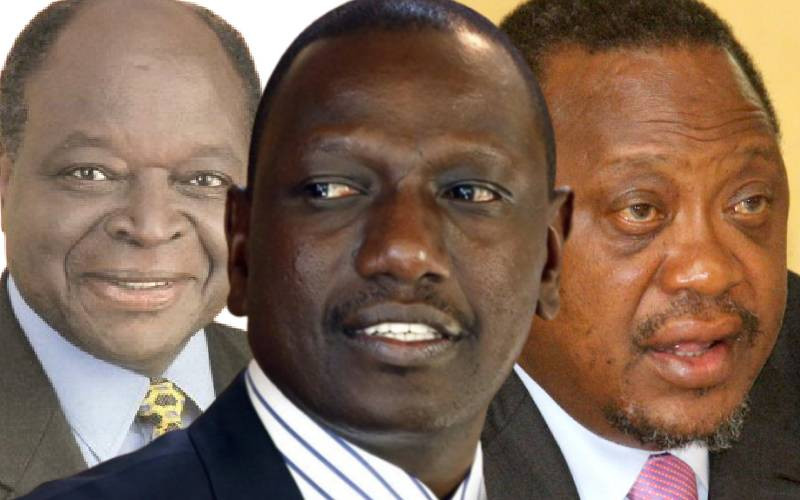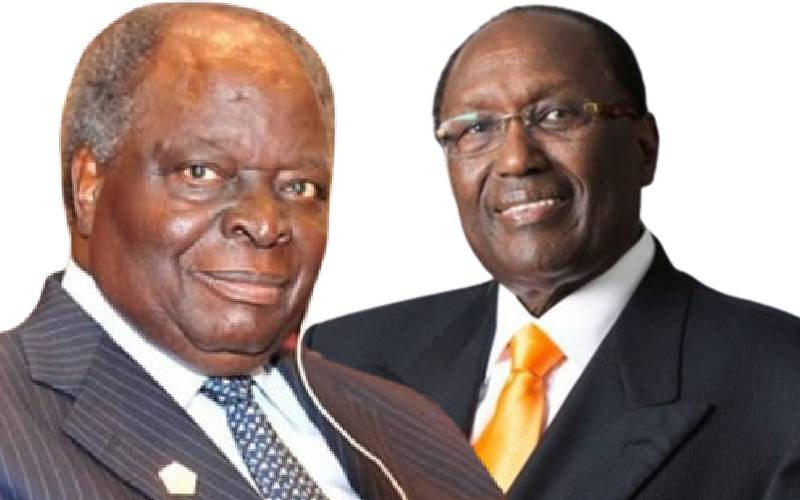 |
|
Retired President Mwai Kibaki. (Photo:Standard/File) |
BY Hussein Mohamed and NJIRAINI MUCHIRA
Kenya: A popular maxim avers that numbers don’t lie. There is no better moment in history to put this idiom to test than a time when President Kibaki, arguably consummate economist, is gearing to retire.
Ten years ago, the President ascended to the pinnacle of the country’s leadership on the promise of economic renaissance declaring in his famous December 30, 2002, speech; “You have asked me to lead this nation out of the present wilderness and malaise onto the Promised Land. And I shall.”
As the curtains comes down on a long political career spanning five decades, analysts view the last ten as more significant in defining President Kibaki’s economic legacy.
“Under President Kibaki, the economic indicators have been impressive and the country has achieved major milestones in the development trajectory,” said Patrick Obath, chairman of the Kenya Private Sector Alliance (Kepsa).
Whereas this is largely undisputable, herein lays the importance of numbers. When he took over in 2003, gross domestic product (GDP) stood at $13.1 billion according to the World Bank, making Kenya among the worst performing economies in the world. A decade later, GDP has tripled to $33.6 billion, a substantial expansion.
When measuring in terms of GDP per capita, growth has been recorded from $402.1 to $476.8, while GDP growth averaged 4.7 per cent during his first term before plunging following the disputed elections of 2007. The resilience recorded then has been instrumental in the rebound being witnessed currently.
Past decade
In GDP parameters, analysts contend President Kibaki has lived up to his promise of making the underperforming economy his priority.
“President Kibaki is a capitalist and that is why he has put in place mechanisms for wealth creation,” observed Job Kihumba, executive director at Standard Investment Bank.
This, however, does not give him the right to pop the champagne. This is because other indicators of the economy have been nothing but volatile over the past decade, illustratively raising questions on the long-term competitiveness of Kenyans economy.
Areas that have projected instability include unemployment rate, inflation, exchange rate, and interest rates among others. For instance, unemployment rate averaged 22.4 per cent between 1999 and 2011, but while it hit a record low in of 12.7 per cent in 2006, last year it stood at 40 per cent.
Inflation, on its part, averaged 12.5 per cent between 2005 and 2012 but while by last month it had declined to a record low of 4.1 per cent, last year in November it had skyrocketed to a high of 19.7 per cent.
In terms of the exchange rate, the shilling has averages Sh78.80 to the dollar between 2002 and 2012. In between, it has demonstrated extreme volatility hitting a historic low of 107 mark in October of 2011.
The Nairobi Securities Exchange 20 share index, which is true measure of the underlying economy, has been in a constant state of fluctuation. In 2002, the index was around 1,000 points before it shot up to over 6,000 points in 2006. The index then crushed to about 3,000 points early this year and is only now picking up closing at slightly over 4,100 points last week.
Stay informed. Subscribe to our newsletter
While analysts contend that under Kibaki, the economy has performed exceptionally well, the fact that growth ran parallel with deeply rooted corruption blackens an otherwise remarkable achievements.
Far reaching
During his watch, the country has lost billions of shillings to mega scandals that include Anglo Leasing scam in which the country is estimated to have lost a staggering Sh50 billion in phantom projects, the Triton scandal that cost the exchequer Sh7.8 billion and the Grand Regency Hotel fiasco in which the country lost Sh2.9 billion.
Other scandals that have clouded his economic exploits, which made Kenya to continue being ranked as most corrupt country in the Transparency International Corruption Index, besides being tagged as ‘a swamp of flourishing corruption’ by Wikileaks, include the donor funded Free Primary Education, City Council cemetery, Ministry of Water scams, Kazi Kwa Vijana and the Maize scandals.
Against this mixed performance, it would be interesting to know what does the volatility of the economic indicators project about the country’s economy in general and President Kibaki’s economic model in particular?
According to analysts, Kibaki has largely been less concerned with short-term upheavals and has mainly concentrated on long-term interventions with far reaching impacts.
“President Kibaki’s approach has been to consciously create fundamental structures with far reaching impacts,” notes Kihumba.
In deed this explains why under him, the Government has developed policies that anchor strategies over a period of time and has given lip service to stop gap measures like the infamous kazi kwa vijana projects.
Soon after taking over power, the Government drafted the Economic Recovery Strategy for Wealth and Employment Creation 2003–2007. When the strategy’s elapsed, it was replaced by the even more long-term growth blueprint, the Vision 2030 master Plan.
Through the policies are premised on the philosophy that the Government need to be pro-active in the revival of the economy and driving growth, they have brought out President Kibaki’s belief in the mixture of both government involvement in the economy (Keynesian economic model) and free markets (Adam Smith model).
For the long-term approach to the economy to bear results, President Kibaki has known that getting the macroeconomic factors right, investing in infrastructure, unleashing the potential of the private sector, securing agriculture, diversifying the economy by exploiting areas like the mining sector and building the human capital through sound education and health facilities are critical. In terms of macroeconomics, President Kibaki’s leadership has largely been characterized by single digit inflation, stable exchange rate and interest rates, which have however been disrupted by drought, effects of the 2007-08 post-election violence and the 2009 global economic crisis.
“Economic fundamentals are not just good, they are exceptional and they have enabled growth to take off,” stated Yvonne Mhango, an economist at Renaissance Group.
The Government has also invested heavily in the revival of erstwhile dead entities like the Kenya Meat Commission, New KCC among others.
Sprung up
More importantly, extensive reforms coupled by the empowering of regulatory bodies like the Central Bank of Kenya, the Capital Markets Authority, the Insurance Regulatory Authority among others has given rise to a vibrant private sector.
In the process enterprises that were largely muzzled like the financial sector, ICTs, retail and services, light manufacturing have sprung up at unprecedented rate.
“Under President Kibaki Kenya has become attractive for investments both local and foreign,” said Obath. But security concerns have been a major impediment that has slowed growth in the various sectors. The results are phenomenal. In 2002, over 70 per cent of bank deposits in the country was in the hands of foreign banks but a decade later this wealth in now in local banks.
While the impacts of invisibles, like for instance ease of access to credits or reduction of bureaucracies when registering a business, over the past decade has not highly celebrated. But massive investments in infrastructures including roads, railways, airports, ports, energy, fibre optic have been spectacular.
Recently, the President has presided the commissioning of some of the key projects like the Thika Superhighway and the Syokimau Railway Station. In the coming days, he is expected to oversee the ground-breaking for others like the Konza Technology City and construction of a second container terminal at the Port of Mombasa.
Economists contend that investments in infrastructure are critical catalyst to growth. According to the World Bank, infrastructure contributed 0.5 percentage points to annual per capita growth in the past decade. It is, however, instructive to note that these projects are being finance through debt, particularly from China, something that has pushed Kenya’s foreign debt to unprecedented levels.
Statistics by the Central Bank show the country’s external debt has skyrocketed from Sh361.7 billion in 2003 to Sh732 billion last year.
The ballooning external debt, coupled by rising domestic borrowing, has translated to a widening fiscal deficit that stood at 7.8 per cent to the GDP last year. “The borrowing should not worry Kenyans because the money has been used in investments and not consumption,” reckoned Kihumba.
As he retires, Kenyans have already made it clear how they intend to remember Kibaki. A survey by Infotrack last week showed that 26.6 per cent of Kenyans will remember him due to infrastructure development, 25 per cent for free primary education and 22 per cent for the new constitution. Whatever the scorecard, only time will tell whether or not Kibaki met the expectation of Kenyans.
 The Standard Group Plc is a
multi-media organization with investments in media platforms spanning newspaper
print operations, television, radio broadcasting, digital and online services. The
Standard Group is recognized as a leading multi-media house in Kenya with a key
influence in matters of national and international interest.
The Standard Group Plc is a
multi-media organization with investments in media platforms spanning newspaper
print operations, television, radio broadcasting, digital and online services. The
Standard Group is recognized as a leading multi-media house in Kenya with a key
influence in matters of national and international interest.
 The Standard Group Plc is a
multi-media organization with investments in media platforms spanning newspaper
print operations, television, radio broadcasting, digital and online services. The
Standard Group is recognized as a leading multi-media house in Kenya with a key
influence in matters of national and international interest.
The Standard Group Plc is a
multi-media organization with investments in media platforms spanning newspaper
print operations, television, radio broadcasting, digital and online services. The
Standard Group is recognized as a leading multi-media house in Kenya with a key
influence in matters of national and international interest.









